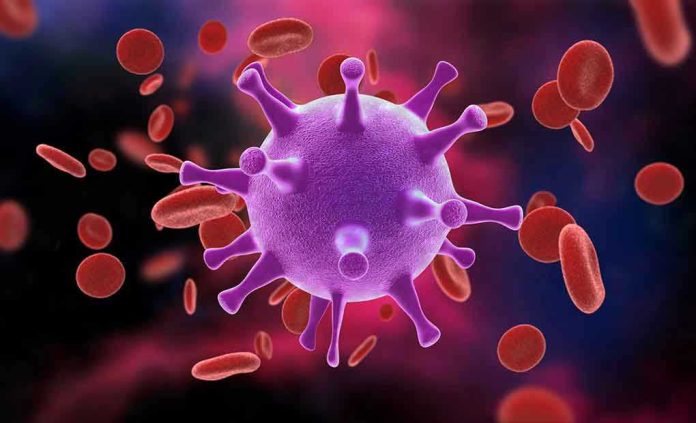
What if the drugs used to keep HIV in check could finally solve the mystery of a far deadlier virus—one that’s been hiding in plain sight for decades, but barely gets a headline?
At a Glance
- HTLV-1 is a lethal, little-known virus infecting millions worldwide—often undetected.
- Recent research reveals HIV drugs can suppress HTLV-1 transmission in animal models.
- This breakthrough could deliver the first real hope for prevention and cure, especially in underserved communities.
- Global health authorities and pharma giants are now racing to include HTLV-1 in clinical trials, with historic policy changes on the horizon.
The Virus with the Most Forgettable Name—and the Deadliest Secret
Some viruses like the dramatic spotlight. HIV? Practically a celebrity. COVID-19? Global media darling. But HTLV-1—Human T-cell Leukemia Virus Type 1? This virus could win “most likely to be ignored at a viral high school reunion,” despite being the first human retrovirus ever discovered and, for millions, the most dangerous. Lurking in blood, sex, and breastmilk, HTLV-1 rarely makes headlines, even though it causes devastating diseases like adult T-cell leukemia and a nasty neurological disorder with a name longer than most tax returns. The kicker: most infected people have no clue they’re carrying it.
For decades, the world’s response to HTLV-1 has been a mix of denial, confusion, and a collective shuffle to the bottom of public health to-do lists. Even in Australia, where some Aboriginal communities face the highest rates on earth, the virus isn’t even notifiable in most states. Translation? Public health authorities can pretend it doesn’t exist. That’s finally changing, thanks to a small army of scientists, community leaders, and one unlikely hero: HIV drugs.
How HIV Drugs Crashed HTLV-1’s Party
Enter the research dream team: WEHI, the Peter Doherty Institute, and a cast of scientists motivated by equal parts frustration and hope. Their mission? To do for HTLV-1 what antiretrovirals did for HIV. The plan was as audacious as it was simple: grab two workhorse HIV drugs—tenofovir and dolutegravir—already battle-tested in millions of humans, and see if they could stop HTLV-1 in its tracks. The result? In humanized mice, both drugs slammed the brakes on HTLV-1 transmission, regardless of whether the strain was international or homegrown Australian.
This wasn’t just a “neat, let’s publish and move on” moment. The same study uncovered a crucial vulnerability in infected cells—a protein called MCL-1. By combining HIV meds with drugs targeting MCL-1, researchers could zero in and obliterate HTLV-1–infected cells, potentially pointing the way to a real cure. It’s the biomedical equivalent of discovering your enemy’s secret lair and then dropping in with the world’s best SWAT team.
Behind the Breakthrough: Advocacy, Skepticism, and a Race for the Cure
None of this happened in a vacuum. Aboriginal community leaders and researchers have been shouting into the void about HTLV-1 for years. In 2018, their campaign—fueled by open letters and a bit of righteous outrage—finally got the World Health Organization to classify HTLV-1 as a threatening pathogen. Then, in 2024, the landmark study dropped, and suddenly, the pharmaceutical world started paying attention.
Now, the researchers are negotiating with drug companies to get HTLV-1 included in ongoing clinical trials. If successful, these HIV drugs could become the first-ever pre-exposure prophylaxis (PrEP) for HTLV-1, offering real hope for prevention, especially in communities that have been ignored for too long. But scientists are quick to caution: what works in mice doesn’t always work in humans. That’s why clinical trials—and the community voices guiding them—are more crucial than ever.
The Ripple Effect: What This Means for You, the World, and the Future of Ignored Viruses
If you’re thinking, “This doesn’t affect me,” think again. HTLV-1’s global reach rivals that of many household-name viruses, and its favorite trick is staying just out of sight. Effective prevention and treatment could transform lives in Australia, Japan, Africa, the Caribbean, and beyond. For pharma giants, the chance to repurpose existing drugs for a neglected killer is both a moral imperative and a business opportunity. For governments and public health, it’s a wake-up call to finally take surveillance, education, and notification seriously.
Beyond HTLV-1, these breakthroughs signal a new era in viral research—where the lessons learned from HIV aren’t just recycled, they’re reinvented. The next time you hear about a “virus no one talks about,” remember: the solution might already be hiding in plain sight, just waiting for someone to ask the right question—or take the right pill.
Sources:
Liebert Publishing, 2023: Global prevalence and epidemiology of HTLV-1
Journal on Oncology, 2025: Mechanisms, treatment, and epidemiology of HTLV-1
Frontiers in Public Health, 2025: Multicenter study of HTLV-1 prevalence in Brazil
Doherty Institute, 2024: Landmark study and advocacy timeline









